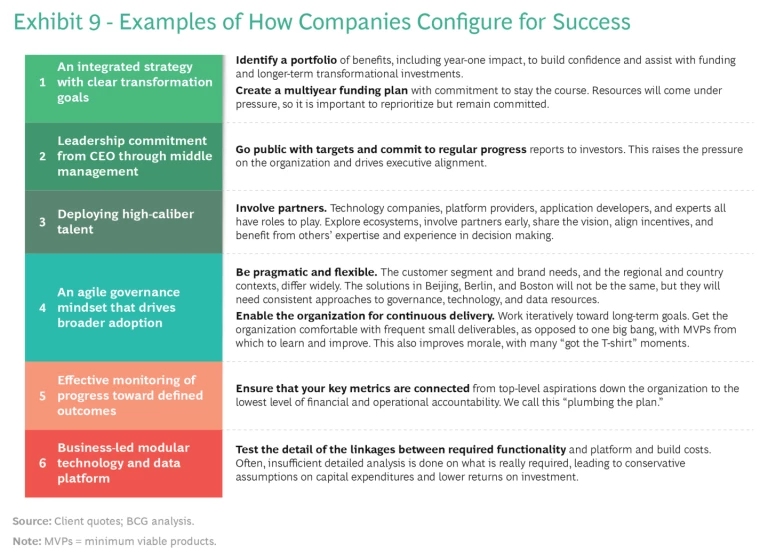
If Failure Is Not an Option, Why Is Success So Rare?
With so much at stake to build digital capabilities that drive customer centricity and productivity, why do so many companies fail? And not just troubled companies—top performers, market leaders, and investor favorites, too. New BCG research shows that 70% of digital transformations fall short of their objectives, often with profound consequences.
Digital transformations are an imperative as today’s leading corporations need to build bionic capabilities in order to harness the potential of disruptive technologies and integrate them into new processes, organization models, and ways of working. This necessity has been accelerated by the pandemic.
Our research shows that more than 80% of companies plan to accelerate their companies’ digital transformations—and with good reason. Overwhelming evidence shows that successful digital transformations drive performance and competitive advantage and propel companies toward becoming bionic.
Digital leaders achieve earnings growth that is 1.8 times higher than digital laggards—and more than double the growth in total enterprise value. In the short term, digital technologies and ways of working offer productivity improvements and better customer experiences. In the medium term, digital opens up new growth opportunities and business model innovation. Successful transformations also set companies up for sustained success; they won’t have to digitally transform again as they master continuous innovation. Investors say that 50% of companies should invest more aggressively in digital capabilities and technology.
But there is a conundrum for management: digital transformations are difficult to execute. And with so much on the line, only 30% of transformations succeed in achieving their objectives. There are good reasons for this, too. Delivering such fundamental change at scale in large, complex organizations is challenging, especially with short-term pressures. Individual leaders must decide whether they want to jeopardize their careers against these odds or risk falling behind.
The technology is important, but the people dimension (organization, operating model, processes, and culture) is usually the determining factor. Organizational inertia from deeply rooted behaviors is a big impediment.
Failure should not be an option, and yet it is the most common result. The consequences in terms of investments of money, organizational effort, and elapsed time are massive. Digital laggards fall behind in customer engagement, process efficiency, and innovation.
In contrast, companies that are successful in mastering digital technologies, establishing a digital mindset, and implementing digital ways of working can reach a new rhythm of continuous improvement. Digital, paradoxically, is not a binary state, but one of ongoing innovation as new waves of disruptive technologies are released to the market. Consider, for example, artificial intelligence, blockchain, the Internet of Things, spatial computing, and, in time, quantum computing. Unsuccessful companies will find it extremely hard to leverage these advances, while digital organizations will be innovating faster and pulling further away from digital laggards—heading for that bionic future.
Digital transformations can define careers as well as companies. The fundamental question on the minds of all business leaders must be: “How can I ensure that my organization is among the 30% of successful transformers?”
With the insights gathered from both our empirical work with clients and a global survey of senior executives whose companies have undertaken transformations, we have carefully analyzed the main drivers of success. The work is evidence based. It shows that getting just six things right flips the odds for success from 30% to 80%.
How Winners Win
Our research involves both internal and external data sets. The internal data comes from BCG’s own experience working with 70 leading companies worldwide on their digital transformations over the past several years. The external data comprises responses offered by 825 senior executives in a detailed survey about their transformation experience.
To determine how companies succeed, we asked executives to assess their transformations on a scale of 1 to 10. We defined success to include the percentage of predetermined targets met and value created, the percentage of targets and value met on time, success relative to other transformations, and success relative to management’s aspirations for sustainable change.
Only 30% of transformations met or exceeded their target value and resulted in sustainable change; companies in this group are in the win zone. Some 44% created some value but did not meet their targets and resulted in only limited long-term change; these companies are in the worry zone. And in the woe zone, 26% created limited value (less than 50% of the target), producing no sustainable change. (See Exhibit 1.)

From a comparative point of view, successful transformations created, on average, 66% more value, improved corporate capabilities by 82%, and met 120% more of their targets on time than those in the woe zone. Compared with the worrisome transformations, winners created 29% more value, improved capabilities by 20%, and met 32% more targets on time.
What Drives Success
Despite the differences in industries, starting points, and goals, management teams wrestle with a very similar group of questions at the start of a transformation:
- Why are we doing this? Do we need to become more responsive to rapidly shifting customer needs? Does our productivity need a step change improvement? Is our ability to innovate lagging?
- What should we do? The scope of digital transformations varies widely, from focusing on people (for example, agile at scale) to overhauling technology and infrastructure, replacing legacy IT platforms, and moving to the cloud. Many companies focus on specific business outcomes, such as personalization and digital marketing, end-to-end customer journeys, digital supply chains, and digital shared services.
- How do we implement the transformation? There are many questions around leadership, governance, resourcing, focus, approach (such as using pilots, incubators, or lighthouses), and sequencing. How do we make sure that product, channels, and support functions work in unison with the technology function, and how do we get middle management on board?
Executives must make many important decisions before starting, and typically there are (legitimately) differing views around the leadership table. These can range from “Let’s manage this in the business units so we can integrate well” to “We need to do something across the entire organization to change the mindset”; or from “Let’s do some pilots, and if they succeed, we can expand to other areas” to “We must commit the whole organization to change.”
When trying to bring everyone along with the overall plan, it can be easy to compromise and lose focus on the transformational aspiration. This is where the trouble usually starts. But among all the decisions that must be made, six critical success factors stand out. The companies that get these six factors right flip their odds of success from 30% to 80%.
The six essential success factors are:
- An Integrated Strategy with Clear Transformation Goals. The strategy describes the why, the what, and the how, which are tied to specific, quantified business outcomes.
- Leadership Commitment from CEO Through Middle Management. The company has high leadership engagement and alignment, including often-overlooked middle-management ownership and accountability.
- Deploying High-Caliber Talent. Management identifies and frees up the most capable resources to drive the transformation program.
- An Agile Governance Mindset That Drives Broader Adoption. Leaders address roadblocks quickly, adapt to changing contexts, and drive cross-functional, mission-oriented, “fail-fast-learn” behavioral change into the wider organization. They deal with individual challenges without losing sight of the broader goals.
- Effective Monitoring of Progress Toward Defined Outcomes. The company establishes clear metrics and targets around processes and outcomes, with sufficient data availability and quality.
- Business-Led Modular Technology and Data Platform. The company puts in place a fit-for-purpose, modern technology architecture driven by business needs to enable secure, scalable performance, rapid change deployment, and seamless ecosystem integration.
When tackling these six factors, companies must satisfy two conditions. First, management needs to make sure that each of the six is adequately addressed in their planning, preparation, and execution. Most companies in the worry and woe zones put effort into this. The problem is that these organizations did not address each factor sufficiently.
Sufficiency can often be a vague term and is susceptible to embellishment, especially when program leaders are justifying their plans in order to get sign off and resources. In the sections that follow, we provide a readiness checklist for each factor that companies can use to assess their positions. Imagine a high-jump contest. All the contestants have been practicing, all have prepared for the competition. But only those who clear the bar will advance. The defining questions that we provide, based on empirical evidence, will help companies determine whether their chances of clearing the bar are low or high.
Second, it is crucial to address all six factors. (See Exhibit 2). Companies that adequately addressed only three or four failed.

We tested more than 35 factors that reflect commitment, strategy, approach, governance, financial and people resourcing, and technology enablers. (See “BCG’s Proprietary Research.”) Out of all of the possible combinations that we examined, none had the same impact on success as these six. One reason is that many of them are correlated with one another. When organizations address one factor effectively, they also tend to address one or more of the others. For example, adopting an agile governance mindset correlates strongly with the adoption of agile principles and culture through the organization. Similarly, the quality of talent correlates closely with turnover rates, so that when organizations bring in strong people to run the transformation, these individuals are also less inclined to leave midway through the transformation.
We examine each of the six factors in depth in the following sections.
Factor 1: An Integrated Strategy with Clear Transformation Goals
All companies undertake some form of strategy setting. But only 40% overcome the hurdles to create a truly integrated strategy: a clear vision backed by a set of strategic imperatives and quantified business outcomes, linking digital to the overall business strategy and sustainable competitive advantage. A strong vision, or sense of purpose, energizes and aligns the organization. The strategy must be translated into specific actions embedded in an actionable business roadmap that addresses use cases and technology, people, and organizational capabilities.
One technology company had been spending money for several years on many discrete digital initiatives. But it made little progress until the CEO decided to align the executive team around company-wide digital imperatives. The management team then designed an approach for implementation that prioritized resources around impact and struck a workable balance between company-wide initiatives and customized approaches at a business unit level.
Exhibit 3 provides the defining questions to assess whether this factor is adequately addressed.

Factor 2: Leadership Commitment from CEO Through Middle Management
Most people understand the importance of commitment by the CEO and other top executives to large-scale change. Yet, by itself, commitment is not sufficient. Companies must also involve the relevant middle managers in the planning and execution of the transformation program to make sure they buy into the goals and strategy. Without this, middle managers often become sources of resistance, defending functional siloes and power bases. As one executive put it, “We knew that it was absolutely critical to address the ‘frozen middle.’ We couldn’t afford our middle management to be cynical or to want to preserve the status quo.”
Companies also need to recognize the threats to people’s careers that transformations can represent. Automation, bionic processes, and new ways of working mean job losses, especially if retraining and upskilling programs can’t compensate. And new digital skills must be brought in. Middle managers feel particularly vulnerable. As organizations adopt agile operating models, they must adjust compensation programs and career paths and then communicate those changes effectively. A motivating purpose, coupled with transparency, is a powerful weapon for bringing people on board and activating behavioral change.
One successful company took the time to involve middle management in the design of the transformation, making it evident that individual managers would be unable to deliver their specific targets unless company-wide digitization succeeded. In another example involving a global organization, management took care to demonstrate the impact of the digital solutions in one operating company before scaling to its functions in other countries. Senior executives also worked hard to respect different countries’ business contexts while remaining firm about the need for full adoption.
In our survey, three out of four executives felt that they had good leadership engagement. In fact, however, only one in three had committed middle-management engagement. In those companies, the middle managers felt motivated and empowered to deliver outcomes.
To assess your organization’s leadership commitment from the CEO through middle management, see the questions in Exhibit 4.

Factor 3: Deploying High-Caliber Talent
Companies often do not have the mix of skills that they need, and they tend to underestimate the skills and expertise of the people required to execute a successful digital transformation. In fact, only one in four organizations in our research cleared the hurdle on this dimension. The successful companies paid particular attention to transformation leadership positions, addressing both digital expertise and broader skills. One executive told us, “You need a core of around 10 digital superstars to drive new ways of working in around 100 others.” Just as important are broad-based skills, such as persistence, pragmatism, resilience, collaboration, critical thinking, creativity, emotional intelligence, and learning agility.
Successful companies demonstrated visible commitment to the organization by appointing the best people with the highest potential to lead the transformation. They carefully assessed the roles and skills required and were prepared to source some roles externally if needed. They also ensured that talent was managed actively—by, for example, rewarding and retaining strong performers and rotating out underperformers.
A large airline understood that the selection of the transformation program manager was key to success. It took the time to find a digital native who also had the leadership skills to be authentic, honest, persistent, and, when necessary, confronting.
To assess whether your organization is playing its part in securing high-caliber talent to drive transformation, see Exhibit 5.

Factor 4: An Agile Governance Mindset That Drives Broader Adoption
This success factor has two elements that turn out to be highly correlated. First, the leadership must govern the transformation with an agile mindset. This means engaging deeply enough to be able to actively steer decisions, tradeoffs, and priorities by serving as an effective escalation point for teams. One executive described her company’s approach this way: “We had a weekly ‘impediments’ agenda item where program leaders could tell executives about roadblocks and get them addressed.” Leaders should also be prepared to adapt the governance and adjust priorities on the basis of changing context. In this way, they demonstrate resilience and reinforce commitment to the vision and goals, especially when there are setbacks or moments of truth, such as funding or competitor pressures.
Second, the leaders must drive agile behaviors broadly into the organization. This requires authentic belief in the behavioral changes required, as well as playbooks, processes, and support to enable the organization to work in a cross-functional, mission-oriented way.
At the start of one successful transformation, members of the executive team were skeptical about agile ways of working. They also recognized that certain corporate initiatives, such as migrating customers to new products and technology stacks, had not been progressing well in the functional organization because motives and incentives were not aligned. The team visited some companies that had deployed agile and became convinced that the move from a functional orientation to a mission-based approach was vital. They oversaw the development of playbooks and operating models and revamped corporate processes around such principles as agile funding and mission-oriented initiatives. At that point, everyone on a mission shared the same targets and worked collaboratively in two-week sprints. The organization began to deliver results much faster.
The research shows that more than two out of three winning digital transformations had effective agile leadership, while 90% of those in the woe zone lacked this factor. In our discussions, executives agreed that they themselves must initiate the change.
To assess whether your organization has adopted an agile governance mindset and is set up to drive broader agile adoption, see Exhibit 6.

Factor 5: Effective Monitoring of Progress Toward Defined Outcomes
Often, monitoring progress is regarded as a simple matter of good corporate hygiene. However, only two out of five organizations in our study addressed this factor adequately, compared with 90% of organizations with winning transformation programs. Measuring success adequately includes:
- Creating a clear mandate and accountability to monitor progress and to tackle roadblocks and challenges
- Defining detailed operational or financial metrics linked to strategic intent
- Tracking outcomes regularly at both program and initiative levels
- Maintaining a single source of truth on data
For example, one organization implementing a new technology stack developed a comprehensive set of KPIs around the delivery of specified functionality. Management used data from the software teams to develop company-wide measures of productivity and defect rates as well as to assess progress toward agreed-upon milestones. It also developed metrics for value realization, measuring customer migration, operational efficiency (such as end-to-end processing without human intervention), and associated productivity benefits.
As one executive said, “It was essential to join the dots between people with accountability for delivering IT solutions and line managers who had signed up for the business impacts. It is not easy.”
To assess whether your organization is ready to effectively monitor progress of your transformation, see Exhibit 7.

Factor 6: Business-Led Modular Technology and Data Platform
More than half of the companies in our research struggled with a lack of flexibility in their technology platforms. Among successful transformations, however, two out of three invested in a business-led, modern fit-for-purpose technology and data platform to support the development and scaling of digital use cases.
Successful CIOs reinforce that the technology and data platforms must be designed around business priorities. They then implement them using best practices for modularity, flexibility, and scalability, with continuous learning and delivery. Deployment is carried out in frequent release cycles in order to adapt to changing business needs and deliver value incrementally. “We knew that deploying new IT architecture without addressing product and process complexity would have minimal business impact, so we focused on radical simplification and then enabled this with new IT platforms,” one company executive said. According to another, “All IT teams were mandated to adopt agile DevOps, and this enabled tight business ownership, rapid iterations, and continuous feedback.”
One company waited until it was in the late stages of its transformation to upgrade the data infrastructure and technology architecture for each country. As the tools were rolled out to frontline brand mangers globally, improvements made in one country could be quickly replicated across the whole organization.
To assess whether your organization is prepared with respect to technology and data, see Exhibit 8.

Beyond the checklists, which are broadly applicable, we also see many innovative ways to address the six success factors. The best companies tailor ways to increase their confidence in success. Some examples are shown in Exhibit 9.

A Bionic Roadmap
Digital natives have shown us that the future of business organizations is bionic. By combining human and machine capabilities, bionic companies have the ability to do things that traditional businesses cannot. This bionic end state is a compelling goal, but achieving it requires a successful execution of a full transformation of both technology and human capabilities.
As companies move from their starting point (whatever that may be) toward becoming bionic, the six success factors for digital transformations reduce the risks of getting there and directly address building the necessary capabilities. (See Exhibit 10.)

Setting Up for Success—and Going Beyond
Our work with clients on digital transformations surfaced other important lessons confirmed by our external research.
Invest in Success
The impact of the six success factors—and the ways in which they materially shift the odds for success—are remarkably consistent across all types of digital transformation, geographies, and industries. (See Exhibit 11.) The recipe for success is the same, although specific action plans to address each factor will vary with company context. The implications are important: don’t get bogged down in the details until you are confident that you are configured for success. Delivering a digital transformation effectively is a highly complex undertaking. Ensuring that the leadership understands the difference between configuring for success and delivering the specifics helps simplify the task.

Adapt as You Proceed
Few organizations have the luxury to develop their digital transformation plans from scratch, with no constraints. In reality, there are often digital initiatives underway, perhaps with subcritical mass, as well as pressing business issues that require short-term delivery. And few executive teams start out fully aligned on the digital agenda. So, when the decision is made to launch the transformation, the six success factors are usually not in place.
It is neither practical nor desirable to delay until each factor has been effectively addressed. Instead, the critical issue is to be aware of the shortcomings for each factor and to put in place a plan to address them. Winners learn to adapt as they proceed. They identify where they are not configured for success and develop solutions to improve their scores as they move forward (much as fully bionic companies do). Exhibit 12 shows an example of this.

Go Big, Go Bold
Our research shows that the same six success factors work in the same combination for all transformations, whether the scope is narrow or broad. There is a statistically insignificant difference in success between transformations with a single digital initiative (say, customer journeys) and those with multiple initiatives (for example, customer journeys, data and analytics, and technology replacement). (See Exhibit 13.) Similarly, there is no difference in success between digital transformations involving just one business unit and those that are company-wide. We also found no correlation between the quantity of resources devoted to the transformation program and the outcome: the 60% of the companies in the worry and woe categories expended a similar or commensurate level of resources as the winners—but for substantially less benefit.

Given that the executive attention, costs, and elapsed time can often be similar for narrow and broad transformations, the implications of this finding should not be overlooked: companies should take the time to configure for success, and then go big with an aggressive scope and bold aspiration.
Create Successful Lighthouses on the Path to Scaling
Even with a bold, company-wide aspiration, however, companies should focus and prioritize their efforts. Transformations that successfully scale up often start by picking one or two major use cases or “lighthouse” opportunities, building a minimum viable solution, and testing and iterating until that solution works in the market and can be scaled. The company then moves to another use case or deploys the initial use case in a second country or business, and works backward to solve for the platforms, infrastructure, and support required to scale up the solutions. This is radically different from assuming that if you build the platform, the businesses will figure out how to get value from it.
Go Beyond Done
Success in business is transitory. Companies need to continue proving themselves to investors and other stakeholders quarter after quarter, year after year; and for every starting point, there is a value-creating road forward. Digital transformations are no different. The point at which success is declared (for example, the organization has transitioned to agile ways of working, or the last workload has shifted to the cloud, or customers have migrated to the new stack), is actually a beginning rather than an end. The success of the digital transformation is the start of a fresh chapter for the business as it learns how to leverage the new capabilities and to drive continuous innovation in new digital technologies, such as AI, augmented reality and mixed reality, and edge computing. Companies that succeed in industrializing continuous innovation as part of their new operating models have become bionic. They will never have to do another transformation program because the digital capabilities and mindset become part of their new way of working.
Know Whether You Are Succeeding
One of the hardest questions—and one frequently asked by boards—is, “Is the transformation on track? What are the risks of spending all this time and effort and failing to achieve our objectives?”
We can provide both a quantitative and a qualitative answer on the basis of our research.
First, you can periodically score your transformation against the six success factors and adjust your action plan to close the gaps. One company is using the success factor framework to assess how well configured they are for the success of a technology stack replacement and agile operating-model transformation. Its initial score placed it in the worry zone, but the leadership team adopted a clear action plan to address this, and subsequent reevaluation showed progress toward the win zone.
Second, some threshold behaviors can provide good indications of whether the transformation program has critical momentum. An assessment of these behaviors will almost inevitably be negative at the outset, but many leadership teams nonetheless find it useful to calibrate progress in this way. Threshold behaviors include:
- How strong is the business pull for digital solutions versus the program push?
- How do the most talented individuals in the organization feel about joining the program? Are they wary of leaving a line role for a temporary position in a program that might fail, or are they excited to join the high-potential team that is shaping the future of the company?
- Are executives advocating diverting funding and resources to other initiatives, or are they defending the digitization budget and resourcing?
- Which are more common: comments that lower expectations (for example, “the plan benefits were overstated”) or upside observations (such as, “now that we have launched the new digital servicing capability, we can extend the use cases and achieve far more than planned”)?
The best leadership teams regularly step back from the detail to discuss the quantitative and qualitative ways to assess whether the transformation is configured for success.
The costs of failure are high. The rewards of success are great. In all industries, COVID-19 has accelerated the need for companies to transform their digital capabilities. There is no time for incremental outcomes. Putting in place the six success factors makes all the difference.
Perspectives on Strategy and Value: Insights on creating sustainable value in an uncertain world.
The authors are grateful to the following colleagues for their assistance with the development of this report: Ali Arsiwalla, Ramendra Awasthi, Tauseef Charanya, Olivier Laugeray Cleaver, Rano Diehm, Suzanne DSilva, Akshaya Mahesh, Tanya Mondal, and Albert Ngan. They also thank the members of the project’s steering committee: François Candelon, Kurt Hogan, Amanda Luther, Kelly Nelson, and Michael Rüßmann.
















